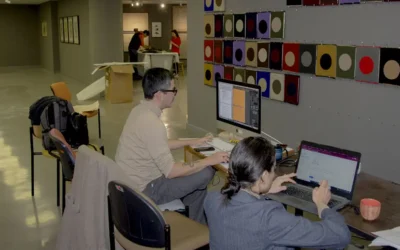Inventory Control for Museums via Mobile Technology
Benitta MacLachlin
As with all museums, your Collections Management Policy will stipulate (and provide guidelines for) regular inventories of your collection, whether they are annual 100% inventories of your entire collection or more frequent random samplings. The introduction of collection management software over the years has made the maintenance and retrieval of inventory information much easier.
From a Binder System to a Software System
Collection management software makes the maintenance and retrieval of inventory information significantly easier. Searching and printing a report from a shared database is definitely more efficient than searching through shelves of binders for that one sheet of paper which represents a particular object in your collection. You just hope it was filed back in the right place after the last user took the sheet out to photocopy!
The Technological Impact on Inventory
Despite the technological advances in the maintenance and retrieval of inventory information, the inventory process itself has stayed quite static over the years. Rather than retrieving binder sheets, new inventory sheets with current object and location data are now printed from the collection management system, but those sheets, fastened to clipboards, are still sent out to the various exhibition and storage areas of the museum in the hands of an army of staff members (should your institution be so lucky!), marching with pencils tucked behind their ears.
Later, once the dust has settled, and you no longer have staff members in contortions trying to verify the elusive number under that Louis XVII chair, you have reams of paper to deal with. The inventory data has been recorded on paper but you must still get it into the computer system somehow.
Steps towards a Solution
Some organizations developed spreadsheets, or used third-party software to take inventories. Once the inventory was completed, they had to export the data from the spreadsheet and load it into collections management software, taking care to match the results of their inventory with the data that already existed in the database.
The Tablet Revolution
Let’s recalibrate. If you have a personal tablet at home, when was the last time you needed to use your old pre-tablet computer? I find that I only need to revert if I have to use the printer attached to the computer, and I’m sure there’s a tablet workaround for that as well.
A wonderful aspect of the tablet is its portability – it can be used anywhere – no cables, no wires.
Imagine the Possibilities
Now, think about what can be achieved with a portable tablet and a browser-based collection management system. All you need to throw into the mix is Wi-Fi. Does your institution have Wi-Fi?
Your inventory list can be a saved search (a “preset” in ARGUS.net lingo) that is shared with everyone taking part. On the tablet, all the search options available on your desktop are still available. You can do a basic search, an advanced search, or pull up a saved preset. Browsing is easy. Editing is easy. All the input controls such as drop-down lists, lexicon selections and typing into fields are there. Using the collection management system on the tablet actually gives you a bigger picture when you’re out in the galleries and storage areas than you would get printing out the inventory sheets.
Perhaps your system tracks where the object ID is physically located on the object, but given the limited real estate on a piece of paper, does that information get printed? In most cases, probably not, but it’s at your fingertips if the entire collection system is on the tablet in your hands while you’re standing in front of a display. No more hunting – you can go directly to the right, back leg of that chair and locate the catalog number. Verify the information for the object on the tablet, and away you go. Easy-peasy! What’s next on the list?
Similar Posts
How to Incorporate Interns in Museum CMS Projects: Data Cleanup and Refinement
A museum expert details how interns can be successfully included in museum CMS projects at the data cleanup and refinement stage.
How to Incorporate Interns in Museum CMS Projects: Data Creation
A museum expert details how interns can be successfully included in museum CMS projects at the data creation stage.
How to Incorporate Interns in Museum CMS Projects: Data Capture
A museum expert highlights how interns can be included in museum CMS projects at the data capture stage
How to Incorporate Interns in Museum CMS Projects
A museum expert highlights how interns can be included in museum CMS projects with three project ideas.
Hosting service
Enjoy all of the benefits of your Lucidea solution with secure, reliable, stress free hosting
Programs & incentives
No matter your size or budget, we’ve got you covered, today and tomorrow



